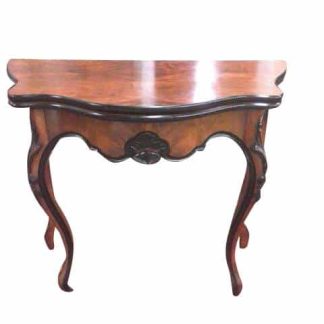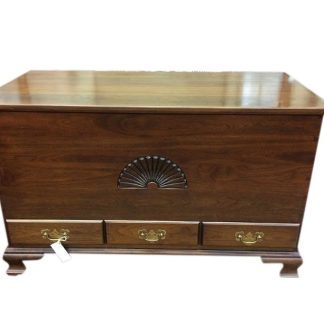Description
Impressive and beautiful antique mahogany paw foot Empire style Sideboard from the McPherson Estate in Gettysburg Pennsylvania. This lion paw four door sideboard has a tall backsplash, beautiful glass knobs and incredible flame mahogany veneer work. It is in the original found condition, with many signs of its age, allowing a buyer to appreciate the piece for all of its age and history.
The overall structural condition of the piece is very good. There are however several chips and repairs to the mahogany veneer, long horizontal cracks to the top, and a reglued (yellowed) glass knob. Some veneer is popping on the far right column. Please see photos and feel free to call us with questions. Restoration and refinish work of this piece can be accomplished if desired.
The piece belonged to the Edward McPherson estate in Gettysburg Pennsylvania. Edward McPherson was a very important figure for Gettysburg, Pennsylvania and for our nation’s history. He was a two time US representative and was appointed by Lincoln as Deputy Commissioner of Revenue in 1863. He also organized Company K of the Pennsylvania Reserves during the Civil War. He worked in the years following the war to preserve the Gettysburg battlegrounds and to erect many of the monuments that can be seen there today. He was also a great writer and published a work on the civil war entitled, “Political History of the United States of America During the Great Rebellion.” He remained in Gettysburg following the war, until his death in 1895.
His speeches to Congress during his service as a representative show his passion and duty to the nation, and his fierce devotion to President Lincoln. He very brazenly criticized his Southern contemporaries in South Carolina for leading the secession movement, which he calls “wicked and diabolical” and “hateful and despicable” (The Disunion Conspiracy, January 1 1861). He warned of the cancerous collusion of those involved in the secession movement, and, just four months before the first shots were fired at Fort Sumter, proclaimed in the marble halls of Washington,
“If all peaceful accommodation be refused…collision must come, let it come and on the aggressors rest the responsibility.” (The Disunion Conspiracy, January 1, 1861)
The name McPherson also lives on in the namesake of the first and bloodiest battle of Gettysburg, on McPherson’s ridge. The battle began at about 8 am on the morning of July 1st 1863 and lasted until mid morning. McPherson’s ridge saw blood soaked fields and the horror of brutal casualties with some estimates of around 2000 men either dead or badly wounded. This site is just a mile west of Gettysburg center and was inherited by McPherson from his forefathers. At the time of battle, McPherson was renting the farm to tenants, who were evacuated before the battle. The Confederates greatly outnumbered the Yankees (3200 to about 7000) and the Union forces faced a terrible defeat. The Confederacy took over McPherson’s stone barn as a field hospital. Today, McPherson’s barn still stands as one of the few original structures on the battlefields.
Edward McPherson’s postbellum home in Gettysburg was recently sold to the Gettysburg College, as many of his remaining descendants have migrated throughout the country. Many of Edward McPherson’s personal and political papers live in several vaults in the Library of Congress in DC.
This piece, along with others collected from the McPherson estate, is testimony to a difficult and fascinating period in our nation’s history and to our struggle to remain true to our Constitution and our values. This piece is historically significant because of its provenance and ties to Edward McPherson.




